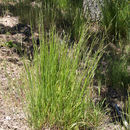Brief Summary
provided by EOL authors
Melica imperfecta is distributed in the southwestern area of North America, including California, Nevada, Arizona and in Baja California, Mexico. The plant is found on arid rocky hillsides, chaparral and even serpentine talus slopes.
With a common name of Smallflower melicgrass, this tufted perennial can achieve a height of 200 centimeters. The inflorescence is solitary, but has more than ten branching elements.
Physical Description
provided by USDA PLANTS text
Perennials, Terrestrial, not aquatic, Stems nodes swollen or brittle, Stems erect or ascending, Stems geniculate, decumbent, or lax, sometimes rooting at nodes, Stems caespitose, tufted, or clustered, Stems terete, round in cross section, or polygonal, Stem internodes hollow, Stems with inflorescence less than 1 m tall, Stems wit h inflorescence 1-2 m tall, Stems, culms, or scapes exceeding basal leaves, Leaves mostly basal, below middle of stem, Leaves mostly cauline, Leaves conspicuously 2-ranked, distichous, Leaves sheathing at base, Leaf sheath mostly closed, Leaf sheath smooth, glabrous, Leaf sheath hairy, hispid or prickly, Leaf sheath and blade differentiated, Leaf blades linear, Leaf blades very narrow or filiform, less than 2 mm wide, Leaf blades 2-10 mm wide, Leaf blades mostly flat, Leaf blades mostly glabrous, Leaf blades more or less hairy, Ligule present, Ligule an unfringed eciliate membrane, Inflorescence terminal, Inflorescence an open panicle, openly paniculate, branches spreading, Inflorescence solitary, with 1 spike, fascicle, glomerule, head, or cluster per stem or culm, Inflorescence branches more than 10 to numerous, Flowers bisexual, Spikelets pedicellate, Spikelets laterally compressed, Spikelet less than 3 mm wide, Spikelets with 1 fertile floret, Spikelets with 2 florets, Spikelets solitary at rachis nodes, Spikelets all alike and fertille, Spikelets bisexual, Spikelets disarticulating above the glumes, glumes persistent, Rachilla or pedicel glabrous, Glumes present, empty bracts, Glumes 2 clearly present, Glumes equal or subequal, Glumes shorter than adjacent lemma, Glumes equal to or longer than adjacent lemma, Glumes 3 nerved, Lemma coriaceous, firmer or thicker in texture than the glumes, Lemma 5-7 nerved, Lemma glabrous, Lemma apex truncate, rounded, or obtuse, Lemma awnless, Lemma margins thin, lying flat, Lemma straight, Palea present, well developed, Palea membranous, hyaline, Palea about equal to lemma, Palea 2 nerved or 2 keeled, Palea keels winged, scabrous, or ciliate, Stamens 3, Styles 2-fid, deeply 2-branched, Stigmas 2, Fruit - caryopsis, Caryopsis ellipsoid, longitudinally grooved, hilum long-linear.
Melica imperfecta: Brief Summary
provided by wikipedia EN
Melica imperfecta is a species of grass known by the common name smallflower melic and little California melic.
It is native to the Arizona, California, and Nevada in the United States and Baja California in Mexico. It grows in chaparral, woodlands, montane regions, and other dry areas.
- license
- cc-by-sa-3.0
- copyright
- Wikipedia authors and editors

